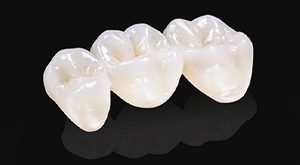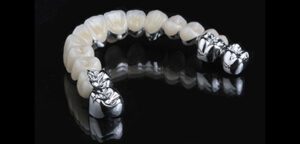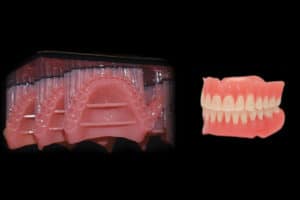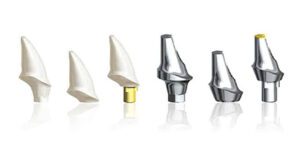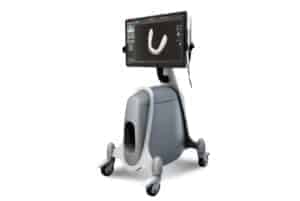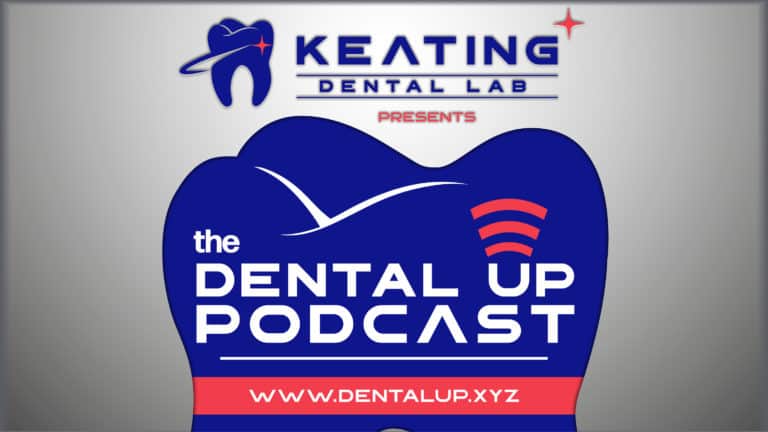Discover more about Danville Materials (www.danvillematerials.com), the fluctuations in global dentistry, and the growth of key markets in the dental world in our latest Dental Up podcast with Garret Sato, CEO of Danville Materials.
Video Transcript:
David: Hello, I’m Dr. David Hornbrook, the Clinical Director of Education Technology here at Keating Dental Lab in beautiful Irvine, California. Keating is a full service lab; not only do we provide unbelievable restorative care … we’re doing some cool things with education as well, not only videos as well, but this podcast. This is our tenth podcast now and we have a special guest, and that’s Garrett Satos. Thank, Garrett, for being here. Garrett:: Mm-hmm (affirmative), Dr. Hornbrook. David: Garrett and I have known each other for … I was trying to think … 15, maybe 15 years. Garrett:: Fifteen years, yeah. David: We met randomly. He worked for Kerr at the time, Kerr Sybron, and we’re at a dinner party outside and I was wearing this cool goldish checkered jacket and he came up to me and said, “Hey. I really like your jacket.” It was actually in San Diego. It was at Loew’s Resort in San Diego. Garrett:: Right. That’s exactly right. David: We’re about the same size so I let him try it on and I meant to bring it today because I don’t wear it anymore; I still have it, so I was going to let you borrow it. It could be like the thing we transfer every year at a certain date. We became close friends and I had a great relationship with Kerr and I had a great relationship with Garrett and then Garrett disappeared a little bit, and then we caught up again this year. Garrett:: Yeah, exactly. David: You’ve done some really cool things. I know you tried to get out of dentistry and they kept reeling you back in, people that have [inaudible 00:01:16] like the Brett Farr or the Peyton Manning. “Okay, I’m done.” It’s like, “No, you’re not done. We’re going to reel you back in.” Right now you’re the CEO of Danville, used to be Danville Engineering. Garrett:: That’s right. David: You’re still … okay. Garrett:: Right, so it’s Danville Materials. David: Okay, and we’re going to talk more about that because that’s a company that’s evolved too. I mean, that was really Ray Bertolotti’s, the Tin Man, and it started up in Danville, California, or near there. Garrett:: Exactly, exactly. David: Now it’s right here in Orange County. Garrett:: Yep, Anaheim, California. David: Okay, which is close, it’s nice, I can’t wait to get out there to see it, so that’s where you’re at now and then prior to that, you were Discus, right? Is that part of the sale to Philips or is it launched? Tell me about that. Garrett:: Yes, with the Discus arrangement, we were in Discus for about a year from 2009 until about the end of 2010 and then we sold to Philips Corporation at the end of 2010, and then at that point, I stayed on with Philips for a little while, and I decided to retire at that point or semi-retire, I guess you could say. David: Good luck with that, a CEO of another company. Garrett:: I couldn’t get out of dental, but I didn’t necessarily want to get out of dental, but there were some personal reasons, so anyway, and at that point, I went on the board for companies like Triodent and worked with other companies to do some consulting for two and a half years, and then started working with a private equity company and they wanted to get into the dental industry, and so having the connections with all of our friends and all of the companies that we know, we were able to locate and identify Danville. At that point, end of 2013, we ended up purchasing Danville Materials. David: Very cool, very cool, so you’ve been around. Garrett:: Then they asked me to run [crosstalk 00:03:08]. David: By the way, we purchased this and by the way, you have a new job. Garrett:: Exactly. David: You’re going to have to come back to work and come in at 8 and leave at 5 and be around. Garrett:: Exactly. David: Prior to that, you were with Kerr for a long time and your title with Kerr was …? Garrett:: I was Vice President of International with Kerr. David: International? International. Garrett:: Prior to that, about nine years with Ormco, when we were a privately held company back in 1987 when I started, so nine, almost 10 years with Ormco and did various jobs there, and then I was over at Kerr as Vice President of International, which I think that’s when we really met, at that point, and so I had that position for a lot of years, 14 years. David: Prior to that was Hallmark. Garrett:: Hallmark, I started … David: Hallmark was like, that’s where you started writing jingles [inaudible 00:03:50]. Garrett:: Exactly, yeah. David: You are my true love, from above. All those dumb things. You probably wrote all those things that I gave all my girlfriends at the time. Garrett:: Yeah, yeah. David: What did you do with Hallmark? I’m just curious. Garrett:: When I got out of school, Cal State Long Beach, they would come on the campus and they would take a look at some of the graduates and they were one of the companies that ended up recruiting me right off the campus, so I was really fortunate there and was able to understand my first big corporate job because Hallmark’s such a big organization out of Kansas City, Missouri, and it was a phenomenal opportunity and so for about three and half years, I worked with Hallmark as a sales associate for them. I thought, boy, I don’t think I can see myself doing this for the rest of my career, greeting cards and wrapping paper, although it was a great foundation to understand how corporate works, and then I had the opportunity to get into the medical/dental world and the rest is history. I mean, the rest is history, and I love dentistry. David: Yeah, yeah, and you’re doing well. As I go around, your name comes up and more so recently, and it’s always so many positive things. Garrett:: I appreciate that. David: Everyone likes Garrett and you’ve done some amazing things and I appreciate our friendship and showing up today, because you’re a busy guy. Garrett:: Not any busier than anybody else. David: Yeah, I wanted to get you on sooner, but you’re too busy for me. Garrett:: No … David: Something you said about the whole dentistry thing, I had the opportunity to interview Damien McDonald. Do you know Damien? Garrett:: Sure. Mm-hmm (affirmative). David: He’s the CEO of Kerr now, for the [inaudible 00:05:16], which is a totally different company than when you were there, right … Garrett:: Exactly. David: … but something he said that was kind of interesting, because he came from the pharmaceutical side. Once you’re in dentistry, you stay in dentistry, and not many dental sales reps or vice presidents or whatever it is, they don’t dabble in dentistry and then go into medicine or pharmacology. They stay in dentistry; they’re going to switch around companies, and it’s really, as you said, it’s the world’s largest cottage industry and you make great friends and I think it gives us the opportunity, us being someone like you, to really understand what’s going on with changes in the evolution, and globally. One thing I’d like to talk to you about too is … so international sales, and I know you’re doing a lot of … How many countries is Danville in? Garrett:: Probably 50 countries [crosstalk 00:06:06]. David: That’s a lot. I didn’t even know there was 50 countries. I thought there was like seven. No, I’m just kidding. Let’s talk a little bit about the international market because I think although we do have some international listeners, most of them are from the US and we live in this little bubble that is different, and of course, we see some of this dentistry from other parts of the world and we think, oh, it’s terrible, it’s what we did 25 or 50 years ago. That’s not necessarily true. I know the Eastern Bloc country is growing huge and fast in the aesthetic world. Garrett:: It really is. David: Tell me how you see global dentistry changing. Garrett:: I think certainly the two major countries that pop out of my mind right now in the rest of the world outside of the United States would be Germany and Japan. Germany and Japan have certainly led in a lot of different areas in technology and some innovation. As you know, some of the best manufacturers of dental come from Germany and Japan, for a good reason. How they practice and what they do, their medicine and their system’s a little bit different than ours, but certainly those two countries lead the way in a lot of technology, as you know. Outside of that, and then you just talked about the Eastern European countries, and they are really catching up as far as understanding the whole aesthetic/cosmetic concept and digitization and all that, and their economies are getting better, so with the population being as big as it is in that part of the world and the training and understanding education that they’re getting, they’re moving fast as far as a demographic into the dental world. As far as what I see outside is that there’s still a lot of that socialized type medicine that goes off there, even in the dental industry, so that’s part of, I think, what the system is and I still think outside of that system, and there are a lot of dentists and there are a lot of customers or patients that work outside of that system. Given that, there’s that opportunity for those people to really get into the higher tech, the digitization, the aesthetics and that type of area, and I can just see that continuing to grow and be part, more of the rest of the world, if you will. David: Yeah, and in the Asian market. Garrett:: In the Asian market as well, I mean, the tiger countries … it’s Japan, Korea, Taiwan and of course China. Those areas are, with the population and again, the education and the advancements, I think they are as well. Just a bigger piece of the dental world and the dental pie. I think international is obviously growing much faster, a faster rate than the US because of their understanding and training. David: And the technology, what it is now … I graduated 1986 from UCLA and the composite, there was a couple available. Maybe you could only do it for Class 1s and in the interior, and then we did Class 2s and then we had matrix bands and finally made it work for us, and so we had this evolution which kept us from growing fast. Now you go into a market like China or India or the Eastern Bloc and all this stuff is already there, so it’s easy to take the amalgam technology that they used forever and say, “You know what? Now we have something that’s tooth colored, more conservative, bonds the tooth,” and we have all the pieces of the puzzle. Here it is; it’s a system. Garrett:: Exactly. David: I think that’s why it’s growing so fast. I had the opportunity to speak for Kerr, actually, on the sonic field in China last year. I went to three cities, Xi’an, Shenzhen, and Hong Kong, and there was 400 people in the audience. Of course, none of them spoke English. The translator was terrible and I hope they understood my message. They didn’t laugh at any of my jokes, but I ended up not telling jokes. For them, the sonic field was a hu-, it’s like wow, we can place composites, and the economy was good. I know it’s changed a little bit now, but those are huge markets, zillions of people that want to use these products. Garrett:: Yeah, I think that’s true. Maybe a bit of mirage with a lot of people, but certainly the people that can afford good dentistry, I think that population is certainly growing, and with that comes that education, as I mentioned, and I think those that can really afford good dentistry, there’s more and more of those people and they’re becoming more aware of it, so I think that’s why you’re seeing that growth, because in a place like China, where there’s two billion people, the percentage of people that can really afford and understand dentistry has grown quite significantly. I think that’s the key right there and so they’re able to afford the advancements in technology. You see the correct dentist that can do those type of procedures and so that’s the great thing. It’s a great thing. David: Yeah, good. Let’s talk a little bit about Danville, because that’s where you are now, and some people are going to say, “Oh, I think I might use some of their products, and I might not.” You have a lot of products, and when I went on the website … we talked about products … I’ve been involved with Danville, because Ray Bertolotti, who as I mentioned earlier was the founder or one of the original founders, so we’ve been friends a long time. When I first got involved with Danville, it was two products. It was the micro-edger and the tin plater for my gold inlays, and those were the two products. Now, in my operatory, not only in my practice in San Diego, but here at Keating, there’s a bunch of Danville stuff and I looked on your website. I said, “Really, they make this? Really, they make this?” Your laboratories are here, your chemists are here. Do you make all your products, most [crosstalk 00:11:48]? Garrett:: We do. I think that’s maybe one of those things that have been kept secret in the past for no real reason, but we do have an R&D lab here in Anaheim, California, and we do research, development and design here, and we also manufacture all of our products, so I think that’s one thing that a lot of clinicians don’t really know, that Danville does all of our … from soup to nuts, essentially, and a lot of dental companies, as you know, Dave, they don’t, and they private label or … David: Yeah, they’re marketing companies. Garrett:: Exactly. David: They put their label on a product. Garrett:: Exactly, so as we were looking to get into the dental industry with the private equity company, and that was part of the industry expert, to get him in there, was we were looking for something that had that foundation of being able to design and develop product and then also be able to manufacture it, and not have to rely upon a lot of different suppliers for that, and then be able to make it and be able to get out and market it. That’s where we are, and I think there’s a lot of people that don’t know that about Danville. This is the awareness and they’re becoming more aware of that, and then again, like you said, with the foundation of Dr. Ray Bertolotti, not only being a dentist but also a chemical engineer with that … David: An icon … Garrett:: An icon. David: … and a chemical engineer. Not only just a … Garrett:: Yeah, and he has brought a lot of credibility and a lot of great ideas to the organization which we want to continue, to continue to keep that legacy alive. David: One of the things we do at Keating is we really emphasize that all our restorations are USA-made because people, like I said, these marketing companies, and there’s a lot … there’s one in L.A. here … that they go out and they find the cheapest product and they put a fancy label, a lot of pretty girls on the ad, and they sell this product, and everyone says, “Oh, they make that,” when it’s like, no, they don’t make that. I think it’s important, as the economy is changing and everyone’s looking for something that’s cheaper and quicker and easier, to know that a company like Danville is making products here in the US. There’s a big difference. Kind of an interesting story … I told this at a previous one, and this is not against the Asian market or China, but it’s really about how trying to find something cheaper is not always the best. I live in a high rise downtown San Diego. We’re in the middle of a lawsuit with the builder, so it’s 23 floors. It started off in the garage where the plumbing pipes, and this is the sewage pipe which is a little bigger pipe, started seeping a little bit of water. You think, okay, let’s go and fix that, and then all of a sudden someone on the third floor says, “You know, there’s a bunch of crap, literally, stinky water, coming out in my closet.” Now they’re finding that [Bose 00:14:33] Construction, who built the building, instead of just using the iron pipes they’ve always used from a US manufacturer, they were able to get the stuff from China for about 30 cents on the dollar. Saved them millions of dollars, but it turned out that the spec, they had the right outside diameter, but not the right inside diameter, and so as this swirling water comes through, it was making these little pinpoint holes and now they’re probably going to have to replace all the plumbing in the entire building, which is going to be million of dollars. I see that in dentistry as well, whether it be a restoration, whether it be an impression material, whether it be, I mean, whatever it is. I commend you on that, because you could say, “Should we develop this or should we just go to this other country and do it cheaper?” Garrett:: Yeah, exactly. I think that’s something that we do pride ourselves on, and I’m very proud to be part of the organization that essentially Dr. Ray did build along with his partners, of course, but certainly the reliability and the quality of product is something that really attracted us to getting involved in purchasing the company, as well as continuing on with that, truly that mission, is the credibility of product, the reliability of product, as a dentist, as a patient, and bringing value, because I think you’re right. I think as the world gets smaller, but the economy’s not necessarily getting bigger, and everybody’s looking for the value, but the quality and the reliability of product, and our mission is to make sure we’re providing that. I think a lot of people can say that. One thing is, as you said, because we develop and design it, and because we manufacture it ourselves here, we have that full control of that, so shame on us if we can’t do it right, but if you’re buying it from other people or other countries, you don’t know where it’s coming from or how it really is being made. David: Yeah, and you got the opportunity to be almost an entrepreneur in dental development, if someone comes to you. We talked earlier before we went on the air about a product that I would like to … we can just talk about, and you have the opportunity to say, “Well, let’s look into it. Let’s make it or not or let’s look into developing something.” Garrett:: That’s the other thing about Danville, and you’re right, you brought up the fact that I worked for the Kerr of old and Sybron, and which we became a very large company and then the Danner corporations, and then obviously a fantastic journey, fantastic places to work, but I think that with Danville, we do have that opportunity to be very flexible and very nimble. “Dr. Hornbrook, please come into our DMRC lab in Anaheim and tell us what you think that the dentists or what you would really like? What works in your hands? What would you really like to see differently?” We can make that on the fly, essentially, because again, we develop and design and manufacture everything there. You don’t have to call China or Germany to see if they can do it. We can do it. David: Is Danville a publicly held company? Garrett:: Nope, we’re private. David: That’s another good thing, so you don’t have to go to your board of directors and say, “Oh, by the way, we want to spend $100,000 developing something. We don’t know if it’s going to work or not.” Garrett:: There is that. Everybody reports to somebody. David: Yeah, but not stockholders. Garrett:: Not the public stockholders, right. Yes. David: We always have to answer to somebody. Garrett:: Exactly. David: As we look in the laboratory, and we look at the future of dentistry, I’d like your take on this. CAD Cam is moving like crazy, right … Garrett:: Mm-hmm (affirmative). David: … whether it be the way we capture our impressions digitally and then how the lab is designing and then where it’s milled. Danville, right, you don’t have a big … you have any products that would lead into … other than the cementation, because ultimately that’s [crosstalk 00:18:01] and you’ve got some great cementation products. Do you see Danville trying to capture some of this digital growth? Garrett:: That’s a great question. We would like to, because I really do believe that … who doesn’t believe that who knows about dentistry? … that we’re shifting towards a digitization era, even if we’re not already there, but it’s going to be more so there, and I think one of the fastest areas that it’s going to happen is the digital scanning and once that becomes even smaller, faster, quicker, cheaper, I think that’s almost going to start really displacing impression material. For us, that is an area that we would like to get into because we have a lot of stake in impression materials. We make impression materials and all the different types of EPSs and … David: You guys make your own [crosstalk 00:18:45]? Garrett:: We do. We do. David: That’s good, because there’s not many companies … Garrett:: No, there’s not, and you know the five or six. David: Yeah. In fact, a lot of companies are selling impression material to you. They buy it somewhere and from the same people that bought it there too and just have another label on it, another name, so I didn’t know that, and so that’s why I was curious because you were telling me you make all your own stuff. That’s awesome. Garrett:: Yeah, when you come and visit us, David, you’ll see our facilities. David: Can I mix … Garrett:: You can. You can. It’ll be like a baker in a bakery shop, but yes, so we have a very big stake in impression materials and although it’s a big category, I do see that becoming more displaced, with the digitations of scanners, and then as you said, the CAD Cam [inaudible 00:19:26] and all that, so probably Danville will not go into the equipment side of that because it’s just not in our wheelhouse. It’s just not where we play. We’d rather play in the materials consumable side and come up with some breakthroughs that are beneficial from the consumable and materials perspective. We can leave the digitization to the pros that do that real well unless we buy one, but that would be an area that we would definitely want to make sure we’re covered in because again, because of the impression materials that we do make and we have a good share of that. We want to protect that, and I think that that’s where it’s going to go, but as you say, from x-ray or radiography to the digitization to CAD Cam to milling. The other thing we do do is we make nano composite material, so we can certainly make blocks for that, for the CAD Cams, so that is an area where we’re certainly looking into as well because that’s not going away either. David: It’s not going away, yeah. That’s your expertise, with the R&D, and the scientists and engineers you have is to … the chemistry that you can make something that can be stuck on that CAD Cam machine or that mill. Garrett:: Right. David: Yeah, I see that. CAD Cam growth, obviously … if you had to list three … I’m not going to put you on the spot and make you list five … but three areas that you would see, especially with your experience as global, so if I hired you and I said, “Listen, I started this new company. We want you to run it. What market should we go after? Where do you see change in the next five years to make this successful?” Garrett:: Yes, I mean, we talked about … I think digital is an area where it’s going and I think you have to look real hard in that area and what the new technologies are, the new innovations are going to be, and I think that’s a place where you can try and stay ahead of the game and that’s, I think, where you would definitely want to look at. I think the other area right now that’s pretty hot is the group practice arena, which you know, the DSO arena. I think with all the statistics and the data that ADA and everybody else has formed, this is the fastest growing segment, especially in the United States, and so I think that’s an area where people are coming out of college and then coming to dental school and loaded up with loans, and I think one area for them to go into is that group practice area. You’re seeing it, and a lot of the dentists don’t want to have their own businesses, so they go into the groups, so I think that area’s growing. That’s an area … David: That changes your business model a little bit because now that thing they usually sell for a dollar, I’m coming to you and I’m saying, “Listen, I want 100 of them but I only want to pay 60 cents.” Garrett:: Exactly, so for Danville, it works out well because again, we talked about credibility, reliability and quality, but we also talked about value, so we’re able to cap into that segment of the market versus maybe some of the bigger companies that have … they don’t have a lot of overhead to have to deal with and answer to the public. I think those are some of the things that we look at, so digitization would be an area, of course. I think the DSO group practice arena is another area, and of course, international. Of course, global, as you mentioned, continue to mention, and having been out there myself for over 18 years running the global world, it’s only getting bigger. The large companies like GCEs or the [Havacars 00:22:54] of the world out there in those areas, they’re just growing like crazy and they’re serving the rest of the world outside of the United States very strongly. I think there’s a lot of opportunity in the key markets globally, absolutely. David: Yeah, it’s not slowing down. Garrett:: It’s not slowing down. It’s speeding up. David: I haven’t done a podcast with people that have looked at the demographics of growth, but I had a good conversation with someone the other day about … 2009-2010, when everyone thought the sky was falling, the practices went like this, which is aesthetic or high-end practices, and that’s where the DSOs, they got crazy busy because people just didn’t need dentistry and they did that. Now I see the growth coming back up. I mean, my own personal practice, we’re going to have a record year where 2010, it was like our worst year ever in 28 years I’ve been in practice. Are you seeing that? I mean, the way we would track it here at Keating would be, “Okay, how many crowns are people doing a month, or what kind of crowns?” The economy’s either doing well or not, the dental economy. What are you seeing at Danville? Did you see that as well, where the dentists aren’t getting busy or selling less, and now, is it picking up? Garrett:: Yep, yep, so I think you’re right, after the ’08/’09’/’10, that was a hit for the whole dental industry. Dental never really had taken a dip because it was almost recession proof, but I think we certainly saw it. I mean, you as a clinician certainly saw it in your practices, and then it started coming back in about ’11/’12/’13/’14. It’s starting to come back and probably even out and getting ahead of the game, but I still think that the economy is not, I don’t think, where you hear a lot of it in the media, where we’re really booming, and so conservatively for us at Danville, we look at that and, again, try to make sure that we’re looking at value playing in the marketplace. If we can set pricing in an area where everybody can afford that, and if a doctor is losing some patients, but he’s going to have to cut his costs down a little bit, I think Danville Materials can certainly come in to help them with that dilemma or that situation and be a solution solver there. Yeah, I don’t see it per se that we’re going back into … what was it, the 2000s, the heyday, and there was tons of oral rehabilitation going on and people spending money left and right. David: There’s dental practices that were cosmetic only. Garrett:: Cosmetic whitening was going through the roof at the time, so I think that those are some of the things that you don’t see as prolific today. I think it’s a little more conservative in the dental office. It’s a little more conservative with the people spending the money now, but that’s what our general voice of customer that we’ve been seeing. David: Yeah, good, good. I’m going to switch topics a little bit, because actually our speaker next week is Jack Hadley who owns My Social Practice, and he’s going to talk a little bit about dental practices and how to utilize social media and how the whole marketing has changed, and I’ve had the opportunity to talk to some other CEOs and presidents of other major dental companies, and they’re getting out of the trade shows. They think trade shows are a big waste of money. It costs them tens and tens of thousands of dollars to be there and the numbers of dentists that are going is decreasing … Garrett:: Lower, yeah. David: … the number of sales they make at the show is decreasing. As a company and as a CEO of a company, you’ve got to make these important decisions. How are you creating value? If you came out with a new product tomorrow, the Hornbrook Super Bond … Garrett:: We will, we will, David. David: … how would you take it to your team and say, “How are we going to create value, create value, market or whatever to the dentist?” Get your education, print, media … Garrett:: That’s a great question, and we have one of those discussions, of course, because we want to make sure we’re doing the right things as we go to market. The trade shows were also one of those big things in the ’90s, of course, and everybody went to them, even in the early 2000s. I think they’re becoming less and less of it just because of the data shows. Your return on investment isn’t as good as it could be or should be, although there has to be some presence, and especially if you’re a Danville and you don’t have the big presence as the big companies do. We want to have a presence, so I always say, “Well, let’s be small and smart about it, but let’s try to be mighty,” so at the booth, it’s what do you have there, what are you featuring, who are you featuring, to really launch maybe your new product, your new technology? I think that’s important. Of course the other way is, which we really believe, is that peer to peer interaction, and that’s the best way I think dentists buy, maybe correct me if I’m wrong, but we’ve always known this and [crosstalk 00:27:41]. David: It’s a podium-driven industry and it’s always been that way. Garrett:: It’s a podium … exactly, and so I think that we certainly like to think that we’re fair to all the key opinion leaders, but we certainly try to pick and choose those that will use our product and as you’re just sampling some things, and make sure you like that, and from that perspective, you’re on the podium or you’re publishing. You’re talking about the product. I think for us, that’s one of the most powerful ways to get the product out there in the right credible, reliable way again, and I think that we’ve done that, I think, tremendously back in the Sybron days. I think that was one of our big core competencies, and I try to take from that playbook, that we really try to treat the clinician well and I think the clinicians buy from clinicians better than they’ll buy from a sales person or buy from a company. David: Yeah, absolutely. Garrett:: That’s really our go-to-market, so if I were to give anybody advice about how to go to market in the dental world, it’s really get to the relationships with the doctors … David: It’s like a grassroots, almost a little bit. Garrett:: Yep, that’s right, that can really influence. David: Do you use social media much? Garrett:: We do a little bit of it, and we’re just talking to KL about that, and so we’re definitely dabbling into that arena for sure, and we’ve revamped our website. We’ve redone our trade booth, again, hopefully smaller but mightier. David: Do you use Facebook? Garrett:: We use some of that Facebook, but we don’t … it hasn’t been as prevalent as maybe we should be or we would like to be, but it’s certainly not out of the realm of what does that look like, certainly for the younger generation of dentists, and so it’s there. It’s coming; it’s not going to go away, and so we’re definitely want to get there, but I think, again, I think if we do the social media things we do, it will be, again, more based upon Dr. Bertolotti … Dr. Miyasaki’s our Chief Dental Officer now who’s a friend of yours, and I know you guys go back a long way, so Dr. Miyasaki’s our Chief Dental Officer so he heads up what the content is going to be on those types of things, and we want that to be valuable content that makes some sense, so when you get on there, it’s hopefully one of those ‘aha’ moments that really does make some sense, but coming from a clinician’s perspective, not from a sales guy’s perspective. David: It’s interesting, you said about the age groups too. I deal with that all the time; dentists in their 20s and early 30s, first thing they say is, “Can I find it on Facebook?” or, “Can I follow you?” Someone that’s 55 or 60 years old, they say, “Really? I have to go to Facebook? I have to create an account?” It’s like, “I mean, really?” It’s going to be different marketing strategies as a company. Garrett:: It is, and [crosstalk 00:30:18] as you know, dentists have just this way of moving slower than it seems like than in most industries or most demographics. Dentists just don’t make the changes as fast. It’s not a bad thing; it’s not a good thing; it’s kind of just what it is. David: Yeah, they’re objective, not subjective. Garrett:: Very conservative, right, and whatever’s working continues to work and why change it, and I think that’s why we haven’t seen just that proliferation of change right into online purchasing and buying from Amazon with dental parts, which is another thing we could probably get into, but yeah, we won’t, but I mean, certainly, could that happen? I’m sure it could … David: Oh, yeah. Garrett:: … but the dentists enjoy the way they purchase from their dealer, their dealer rep. David: Now Danville, is it direct and through a dealer? Garrett:: No, we go through distribution, so [crosstalk 00:31:16] so we go through Pattersons and the Scheins, the Burkharts, the Bencos, right? We go through that and also the rest of the world, we do the same thing. Yeah, so we don’t go direct. David: Dentists now that are listening to this and saying, “I got to check this out. Good products and Ray Bertolotti, and David uses some of these.” Website … it’s not Danville.com. It’s dan … Garrett:: DanvilleMaterials.com. David: DanvilleMaterials.com, okay. Garrett:: Yeah, DanvilleMaterials.com. David: Okay, so they would look at that and … I haven’t been on it. There’s certainly technical information about the products and then they would call their local rep. Garrett:: Yeah, local rep through the distributor channel, that’s correct. David: Through the distributors, yes. We’re going to wrap up. As I told you before we started, I like to make these right around 30 minute, what I call ‘treadmill podcast’. My 30 minutes on the treadmill is just about done, so we’re going to wrap up. Is there anything that you would like to close with here, Garrett? Garrett:: No, thank you very much for the opportunity. It’s great reconnecting again and … David: Absolutely. Garrett:: … I look forward to our continual journey, and I can’t wait for you to have a chance to come over to Danville in Anaheim. It’s nice to be able to be here at Keating Labs and get to know what’s going on. David: Yeah, it’s nice to be close. Garrett:: Yeah, it’s great, [crosstalk 00:32:24] it’s great, and I look forward to doing a lot more things with you and Sean and his lab, absolutely. David: People come from all over, our listeners from all over the country. They go to Disneyland for the weekend or something. Could they call ahead an invitation, maybe tour or visit Danville? Is that something that you do? Garrett:: Absolutely. I’m glad you bring that up. We have a lot of folks coming through now, and because we’ve been in the industry for quite a while, I have a few friends. It’s really nice to be able to have people call and say, “Hey, I’m coming from New York and can we stop in and see you?” It’s great to be able to walk them through what people don’t really know about Danville, like I said. You have a real R&D department with real Ph.D. chemists. They’re all dental chemists, and then they see how the product’s made and I think that’s just gives them a better feel and a sort of warm and fuzzy feel about the organization, so we’re excited about that. David: There’s your invitation. Call ahead. Garrett, thank you so much. That was so awesome. Garrett:: David, great to see you. David: We’re going to have to do this again. Garrett:: Absolutely. Absolutely. David: We’re going to wrap up. That’s our 30 minutes. I appreciate you listening and watching us. I had a lot of fun as always. Garrett:: And I did, as always. David: Check out our other podcasts as well as some of the videos and some of the product reviews and blogs that we do. Go to dentalup, all one word, dot xyz. Hope I see you soon. You have an invitation from me as well. If you’re ever in this area, stop by Danville, stop by Keating Dental Lab. We’re about five minutes from Disneyland and it’s a great place to live, Irvine, a great place to visit, southern California. Talk to you soon.

